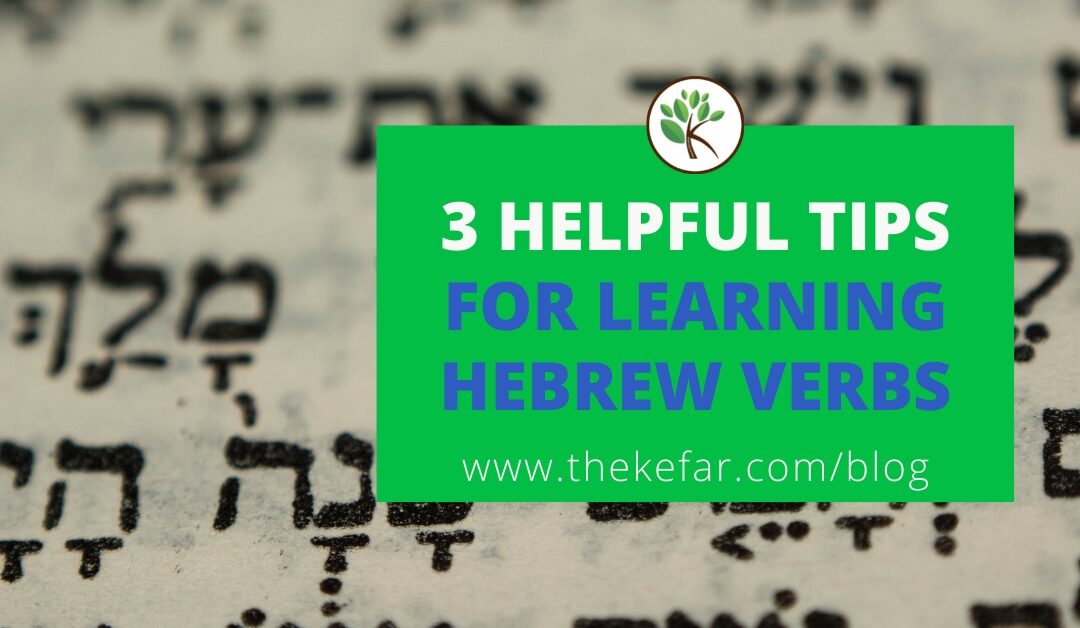Over the past few weeks, our daily everyday Hebrew Sentence Series have focused on doing laundry in Hebrew – washing, drying, and putting away clothes. If you’re new here – welcome! – you can check out the first, second, and third review posts before reading this one. As always, I want to start with a reminder of the point of these everyday Hebrew sentence lessons.
These sentence videos help you learn Hebrew words and phrases that you can use in everyday Hebrew conversation. The way the Hebrew sentences are presented varies each week to focus on a particular action, and that’s to help you learn the language in context. The context helps you learn Hebrew sentence structure, what prepositions to use with what verbs, what verb conjugations to use, the genders of nouns, and so much more. You’re learning to actually use the words, instead of being caught up in grammar and mechanics.
Sounds good? Yes? Perfect! So, BO’U NATCHIL בואו נתחיל – let’s get started!
Hebrew Verb Notes
Before reading, consider your answers to the following questions:
1. Which two verbs from the past three series mean “to put”?
2. How can you tell that a Hebrew verb is feminine plural?
3. The verb TOLIM / TOLOT / תולים / תולות has the same conjugation pattern as a verb from the last review – which verb?
4. Which two verbs from this latest group of videos (Washing Clothes, Drying Clothes, and Putting Away Laundry) have the same conjugation pattern?
🔵 There were eight new Hebrew verbs in the last three everyday Hebrew sentence series: fold, gather, hang, put (2 ways), remain, turn on, and wash [laundry].
🟢 You now know of two ways to say “wash” in Hebrew. SHOTEF שוטף (can also mean “rinse”) is used to wash things like your hands, face, or even dishes. MECHABES מכבס is used for laundry – clothes, sheets, towels – think stuff you’d put in a washing machine.
🔵 You also know two ways to talk about putting things away: SAM שם and MANIACH מניח (presented in their plural forms in the videos). SAM שם means “put” or “place,” as in HEE SAMAH SEFER AL MADAF היא שמה ספר על מדף, meaning “she puts/places a book on a shelf.” MANIACH מניח is more like putting something away, as in HEE MANICHAH BEGADIM BA’ARON היא מניחה בגדים בארון, meaning “she puts clothes away in the closet.”
🟢 The Hebrew verb OSEF / OSEFET / OSFIM / OSFOT אוסף / אוספת / אוספים / אוספות has the same exact conjugation pattern as a few of the verbs we’ve done so far, like ZOREK זורק, SOGER סוגר, and SHOTEF שוטף. Notice the same sounds in this pattern (o-e / o-e-et / o-im / o-ot).
🔵 The Hebrew verb TOLEH / TOLAH / TOLIM / TOLOT תולֶה / תולָה / תולים / תולות has the same exact conjugation pattern as a couple of verbs we’ve done so far, like OTEH עוטֶה and SHOTEH שותֶה. Notice the same sounds in this pattern (o-e / o-a / o-im / o-ot).
🟢 Two of the verbs from this latest Hebrew series have the same conjugation patterns: MECHABES / MECHABESET / MECHABSIM / MECHABSOT מכבס / מכבסת / מכבסים / מכבסות and MEKAPEL / MEKAPELET / MEKAPLIM / MEKAPLOT מקפל / מקפלת / מקפלים / מקפלות. Notice the same sounds in this pattern (me-a-e / me-a-e-et / me-a-im / me-a-ot).
🔵 The Hebrew verb NISHAR נשאר means to remain or stay behind. If I’m staying home, for example, I’d say ANI NISHERET BABAYIT אני נשארת בבית.
🟢 When you watch future Hebrew sentence videos, continue to pay attention to the verb sound patterns, and see which ones sound like verbs you already know.
Exercise 1: Hebrew Verbs Match
Complete each sentence with the correct Hebrew verb.
Exercise 2: Hebrew Adjectives
In this exercise, you will identify the right Hebrew adjective to use to describe different nouns based on the nouns’ gender and number.
Exercise 3: Hebrew Vocabulary Quiz
In this exercise, you will read different questions in English and choose the most appropriate Hebrew answer.
Exercise 4: Hebrew Listening Comprehension
In this exercise, you will hear Hebrew sentences that use words from the everyday Hebrew sentence series 10-12 (along with some words from earlier series). Translate each Hebrew sentence into English.
DISCLAIMER: I could only input one correct option, even though you might be able to translate the sentence correctly in a number of ways. For example, הִיא מַחֲזִירָה אֶת הָעֵט could correctly be translated as: (1) She puts the pen back (2) She returns the pen (3) She puts back the pen (4) She is putting back the pen (5) She is putting the pen back or (6) She is returning the pen. If I put in option 1, but you typed in any of the other choices, the system will mark it as incorrect, but you go ahead and give yourself those points anyway!
To try and keep it simple, all of the answers are in the simple present (i.e. you write, I close).
Do you still have questions about the lessons from the last three everyday Hebrew sentence series (washing clothes, drying clothes, and putting away laundry)? If so, let me know what you’re still wondering about in the comments!
Zehu זהו – that’s all folks!
I hope you enjoyed these Hebrew exercises and found them helpful, and make sure you’re subscribed to my channel so you don’t miss a single sentence!
Until next time,

If you liked this post, please do at least 1 thing from this list:
📝 leave a comment below
🥰 share it on social media
📲 email or text the link to this post to a friend
☕️ buy me a “thank you” coffee
💻 join the Patreon community for exclusive content
Thank you! 💙

3 Tips to Learn Hebrew Verbs
Today I want to share with you three tried and true tips to help you learn Hebrew verbs, and...

